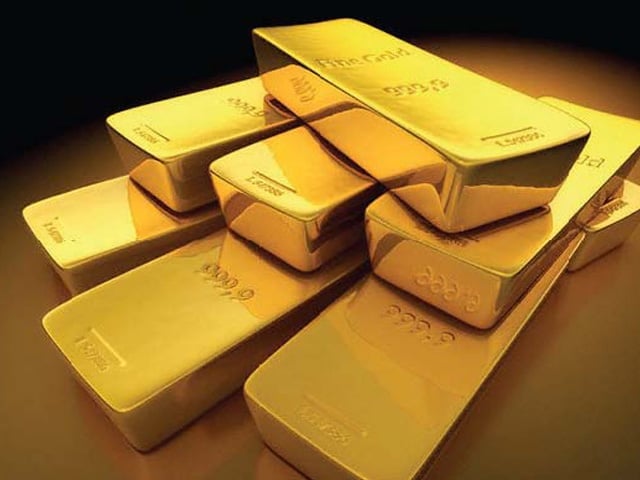KARACHI:
The price of gold has surged to record levels, crossing $3,000 per ounce, raising questions about the factors driving this unprecedented rally and its broader economic implications.
The global economy is undergoing significant shifts, and gold, traditionally seen as a safe-haven asset, has become a focal point for investors, central banks, and governments. From geopolitical tensions to monetary policy adjustments, multiple forces are fueling this gold rush. This article explores the reasons behind the surge in gold prices, the impact on the US national debt, why the US is considering revaluing its gold reserves, and what this means for Pakistan.
Several factors have contributed to the sharp increase in gold prices – the key driver being the aggressive accumulation of gold by central banks, particularly in China, Russia, and emerging economies. Countries are increasingly seeking to diversify their reserves away from the US dollar, fearing economic sanctions and global financial instability.
The World Gold Council reported that central banks purchased over 1,000 metric tons of gold in 2024 alone, and anticipated that they will likely continue their net buying trend in 2025.
Another reason is the heightened tensions in Ukraine, the Middle East, and Taiwan, which have increased demand for gold as a safe-haven asset. Historically, investors flock to gold during periods of global instability, as it retains value in times of crisis. The ongoing conflicts and fears of further escalations have amplified the appeal of gold as a hedge against uncertainty.
Expectations of the US Federal Reserve’s interest rate cuts have weakened the US dollar, making gold more attractive to investors. Lower interest rates reduce the opportunity cost of holding non-yielding assets like gold, increasing its appeal. Additionally, investors expect inflation to persist, further driving up gold’s value as a hedge against currency depreciation.
Also, rising inflation and concerns over a potential economic slowdown in major economies have spurred the demand for gold. As purchasing power declines, investors turn to gold to preserve their wealth. Similarly, the imposition of tariffs and the potential for trade wars can create economic uncertainty, prompting investors to seek the safety of gold.
Finally, the surge in gold prices is also being fueled by speculative investments. Institutional investors and hedge funds are increasingly betting on gold, further pushing prices higher. With global stock markets experiencing volatility, gold has become an attractive alternative investment.
How higher gold prices can reduce US debt
The idea that rising gold prices could reduce US debt stems from the fact that the United States holds a significant amount of gold reserves. These reserves are officially valued at a fixed rate of $42.22 per troy ounce, a figure set in 1973. If the market value of gold significantly exceeds this official valuation, some argue that revaluing the gold reserves to current market prices could add hundreds of billions of dollars to the US Treasury’s balance sheet. This accounting adjustment could theoretically improve the nation’s debt-to-asset ratio.
However, it’s crucial to understand that this would be primarily an accounting manoeuvre. It wouldn’t generate actual cash flow for the government to directly pay the debt. While it could offer a symbolic improvement in the US financial position, it wouldn’t address the underlying issues contributing to the national debt, such as government spending and revenue.
The US holds the largest official gold reserves in the world, approximately 8,133 metric tons. However, the US government currently values its gold at just $42.22 per ounce, a fraction of the current market price. This rate was established in 1973, after the collapse of the Bretton Woods system. The market price of gold is now significantly higher (around $3,145 per ounce as of April 3, 2025).
Revaluing the gold reserves to the current market price would dramatically increase their reported dollar value on the US Treasury’s balance sheet. If the Treasury were to revalue its gold reserves at market rates, the total valuation of US gold holdings would skyrocket, significantly improving the country’s balance sheet.
Gold price surges often signal inflationary pressures. While inflation erodes purchasing power, it also reduces the real burden of outstanding debt. The US government repays its debt in nominal terms, meaning that if inflation rises, the real value of the debt shrinks. This phenomenon, known as “debt erosion,” helps countries manage high debt levels over time.
Why is the US revaluing its gold stock?
There is growing speculation that the US government may consider revaluing its gold reserves. If these were revalued closer to market prices, it would significantly increase the official asset value of US gold holdings, improving the financial position of the Treasury and the Federal Reserve.
The revaluation of gold would allow the US government to leverage its gold reserves more effectively in debt management strategies. While the government is unlikely to sell large portions of its gold, a higher valuation would improve financial credibility and provide additional fiscal manoeuvrability.
What it means for Pakistan
For Pakistan, the surge in gold prices brings both economic challenges and risks. Pakistan is a net importer of gold, primarily for jewellery and investment. Higher gold prices will increase the country’s import bill, exacerbating its already fragile trade deficit.
The increase in gold prices could spill over into domestic inflation. Additionally, if gold price hikes signal broader global inflation, Pakistan’s import-dependent economy could face rising costs for essential commodities.
A surge in gold prices often correlates with a weaker US dollar and a shift of global capital towards safe-haven assets. This could lead to further depreciation of the Pakistani rupee.
The writer is the Assistant Professor at SZABIST


